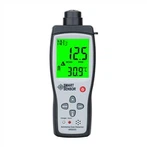The method of measuring Zener diode with pointer multimeter
The voltage regulation value of the voltage regulator tube is generally greater than 1.5V, and the resistance file below R×1k of the pointer meter is powered by the 1.5V battery in the meter. Like a diode, it has complete unidirectional conductivity. However, the R×10k gear of the pointer meter is powered by a 9V or 15V battery. When the R×10k is used to measure a voltage regulator tube with a voltage regulation value less than 9V or 15V, the reverse resistance value will not be ∞, but will have a certain value. Resistance value, but this resistance value is still much higher than the forward resistance value of the Zener tube. In this way, we can initially estimate the quality of the Zener tube.
However, a good Zener tube also needs to have an accurate voltage regulation value. How to estimate this voltage regulation value under amateur conditions? It's not difficult, just find another pointer watch. The method is: first place a meter in the R×10k range, and its black and red test leads are respectively connected to the cathode and anode of the voltage regulator tube. At this time, the actual working state of the voltage regulator tube is simulated, and then another meter is placed in the On the voltage file V×10V or V×50V (according to the regulated voltage value), connect the red and black test leads to the black and red test leads of the watch just now, and the measured voltage value at this time is basically this Regulated voltage value of the Zener tube.
Saying "basically" is because the bias current of the first meter to the regulator tube is slightly smaller than the bias current in normal use, so the measured voltage regulator value will be slightly larger, but basically the same . This method can only estimate the Zener tube whose voltage regulator value is less than the voltage of the high-voltage battery of the pointer meter. If the regulated voltage value of the Zener tube is too high, it can only be measured with an external power supply (in this way, when we choose a pointer meter, it is more suitable to choose a high-voltage battery with a voltage of 15V than 9V).
The semiconductor diode test method is shown in Figure 1, and the multimeter is set to R×100 or R×1k. Connect the negative test lead (battery + terminal) of the multimeter to the "+" pole of the diode; connect the positive test lead to the "-" pole of the diode, that is, apply a forward voltage to the diode, the diode is in a conducting state, and the ammeter reads its forward resistance value . If the measured silicon diode is in the middle of the surface or a little to the right of the middle, it indicates that the forward characteristic is good. Then reverse the positive and negative test leads, the positive test lead is connected to the "+" terminal of the diode, and the negative test lead is connected to the "-" terminal of the diode. At this time, the diode is applied with a reverse voltage and is in a cut-off state. That is, the resistance value is about ∞; if the tested germanium diode, the resistance values of the two characteristics are relatively small. The results of the two tests are as above, indicating that the tube has unidirectional conductivity, indicating that the tube under test is intact. Otherwise it means a bad tube.
To determine the polarity of a diode, through the above two tests, first determine whether it is good or bad. As long as the tube is in good condition, if the measured result is a small resistance value, it means that the measured is a positive resistance, and the end connected to the negative pen of the multimeter is the "+" pole of the diode (remember that the negative pen of the multimeter is the + terminal of the battery E in the meter. ); if the measured resistance is large, the negative test lead is connected to the "-" pole of the diode.






